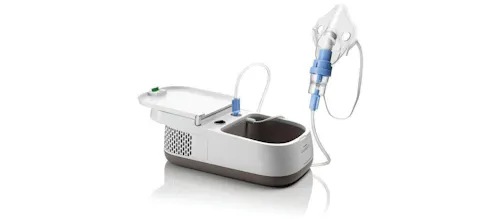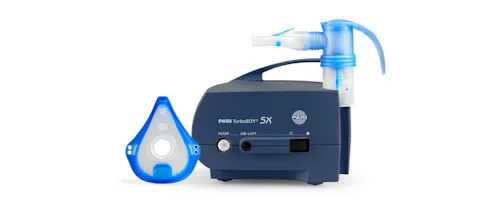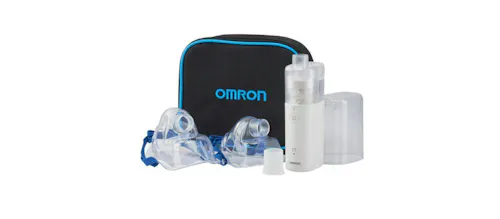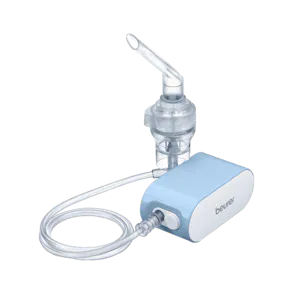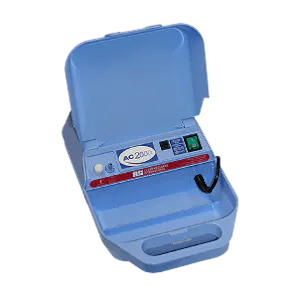Nebulising with a tracheostomy or laryngectomy
A tracheostomy or laryngectomy is an opening created at the front of the neck so a tube can be inserted into the windpipe to help you breathe.

Your artificial airway
A tracheostomy is a surgical procedure that creates an opening through the neck into the windpipe. There is still a connection from the nose or mouth to the lungs. The tracheostomy can be short-term or permanent.
A laryngectomy is the surgical removal of the larynx, completely and permanently. The remaining trachea is stitched to the anterior neck. There is no connection from the nose or mouth to the lungs. Laryngectomy patients are known as Neck Breathers that is individuals who breathe through a neck stoma.
Before your surgery the air reaching your lungs was warmed, moistened and cleaned as it passed through your nose and upper airways. When you breathe in through your stoma, the air is drier and colder than your lungs are used to and the air may also contain particles of dust which can irritate your lungs. The dry air can make your airways produce mucus, this mucus can collect around your stoma and get crusty. To protect your stoma and your airways try to avoid extreme temperatures, fumes from traffic or work places, smoke and dust.
Keeping your airways moist
The air you breathe through the stoma goes directly into your lungs through the laryngectomy or tracheostomy tube. It is no longer moistened as it passes through your mouth and nose. This means the moisture must be replaced and if it isn't the mucus that your airways naturally produce becomes thick. This can make it difficult for you to breathe. If your mucus becomes so thick that you can’t cough it can become very serious and can potentially block your stoma. It can also make you more likely to get chest infections.
What can I do?
There are lots of things you can do to help to avoid these problems such as drinking at least 2 litres of fluids each day; this helps keep the mucus in your airways thin. You can spray a sterile salt solution (saline) directly into your tube to keep it clean and moist. You can also use a filtering and moistening system or you can use humidifiers in your home. Your nurse or therapist may recommend a nebuliser. A nebuliser is a medical device often used with saline to provide a fine mist. The particle size of this fine mist is small enough to reach deep into your airways, providing extra moisture if needed. It can also be used with medications such as bronchodilators when you are no longer able to use an inhaler or spacer. You can read more about how a nebuliser works on this blog post here - What is a nebuliser?
Which to choose?
Nebulisers can be used with a tracheostomy/laryngectomy mask instead of the usual face mask or mouthpiece and if you phone or email we will happily include a standard tracheostomy mask free of charge. If you choose a Pari nebuliser their tracheostomy set is more durable, therefore more expensive and for this there is an extra charge. If your head and neck nurse hasn’t recommended a particular model then which you choose will mainly depend on how often your therapy is prescribed. Some people only need to use it once a day others much more frequently. Think of it like choosing your car, there is no need to buy the top of the range 4-wheel-drive if you only ever use it to pop to the shops. If you’re looking for a simple mains powered nebuliser (that is to plug in at home) then take a look at the Philips Innospire Essence. If you’re nebulising more frequently then it would be worth considering a device with a little more power like the Philips Innospire Deluxe with Sidestream or the Pari Boy Classic. In this blog post we describe these devices in a more detail.
Out and about with a portable nebuliser
Once you become more comfortable with managing your stoma you may feel like it’s time to get back to your normal activities of daily living. Shopping, visiting and travelling with a stoma can be scary and will need a little more planning. You’ll need to take lots of extra equipment you may not have considered before. Your head and neck nurse will have lots of helpful advice. No need to worry about your nebuliser though as nebuliser technology has evolved. Why not take a look at the smaller, lighter, more portable devices that are available on our website? You can find a suitable model here: Philips Nebulisers, Omron Nebulisers, Pari Nebulisers, Medix Nebulisers and Beurer Nebulisers.
The Omron MicroAir U100 and the Philips InnoSpire Go are battery operated mesh nebulisers. Small, lightweight and handheld devices that can easily fit in your pocket. Customers who choose The Omron U100 tend to dispense with the actual tracheostomy mask and hold the ‘mouthpiece’ over the stoma site. Those who bought the Philips Innospire Go do exactly the same but with the mask adaptor provided. Both are perfect for saline and bronchodilators, ideal for helping you get your life back on an even keel. On this blog page we discuss each in more detail and look at the differences between the two. If you prefer a compressor type portable nebuliser then choose the Pari Mini. Mains powered with the option to pick and mix between a D.C. car lead and a battery or both depending on your ambition but don’t forget you will need to order their tracheo set and details are on our website.
Are you looking for further support?
Initially following your operation you are going to need a lot of support both practically and emotionally and there are agencies and medical professionals out there to help you adjust. There is the The National Association of Laryngectomee Club who support, educate, communicate, and offer a vital forum for laryngectomees through their 80 clubs up and down the UK. The National Tracheostomy Safety Project has lots of useful patient information as well as links to other patient groups where you can find support. And don't forget that we’re here to help you too. If you need help choosing a nebuliser you can always call us on 01942 701210 or email us for some helpful advice.


